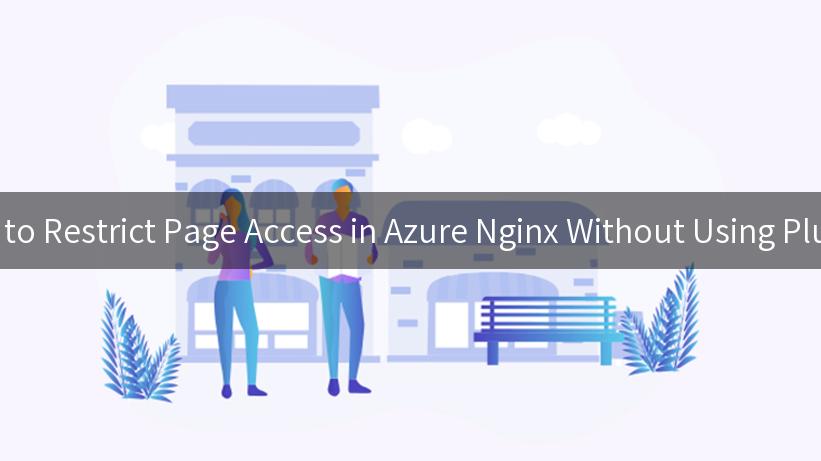
In today’s rapidly evolving digital landscape, ensuring the security of web applications has become paramount. With the rise of AI technologies enabling dynamic content generation and API integration, it becomes increasingly important to manage and restrict access to various resources effectively. This article aims to provide a comprehensive guide on how to restrict page access in Azure Nginx without using plugins, seamlessly integrating enterprise security protocols while ensuring robust API governance.
Understanding Azure Nginx
Azure Nginx is a popular web server and reverse proxy that runs on the Azure cloud. It supports various functionalities such as load balancing, caching, and content delivery. However, one critical aspect of web application security is controlling access to certain resources.
### Key Features of Azure Nginx
- High performance and scalability
- Ease of integration with other Azure services
- Robust security features
- Extensive customization options
Azure Nginx allows you to configure various settings without the need for additional plugins, maintaining a lightweight footprint while providing essential functionality.
The Importance of Restricting Page Access
Restricting access to specific pages or resources is vital for several reasons:
- Data Protection: Prevents unauthorized access to sensitive information.
- Compliance: Adheres to regulatory requirements concerning data access controls.
- Reduced Attack Surface: Limits the potential entry points for malicious activities.
- User Experience: Tailors access based on user roles, enhancing customization for users.
Given these advantages, understanding how to implement access restrictions efficiently is crucial for businesses interested in enterprise security while utilizing AI technologies.
Implementing Access Restriction in Azure Nginx
To restrict page access in Azure Nginx without using plugins, you can leverage various methods. Here are the steps to do so:
Step 1: Prepare Your Azure Nginx Environment
Ensure you have the Azure Nginx server set up and running. You will need the necessary permissions to modify configurations.
Step 2: Define Your Access Policy
Before implementing the actual configurations, define your access policies. Consider the following factors:
- Who requires access (e.g., internal users, external clients)?
- What pages need restrictions?
- Do you want to use IP blocking, user authentication, or both?
Step 3: Modify Nginx Configuration
Open your Nginx configuration file, typically located at /etc/nginx/nginx.conf or /etc/nginx/sites-available/default. You can restrict access by adding specific rules.
Example Configuration:
server {
listen 80;
server_name yourdomain.com;
location /restricted-page {
allow 192.168.1.0/24; # Internal network
deny all; # Deny access to all other IPs
}
location / {
# General settings
try_files $uri $uri/ =404;
}
}
In this example, only users from the internal network can access the /restricted-page, effectively denying all other access attempts.
Step 4: Utilize Additional Header Parameters
For more sophisticated access control, consider leveraging additional header parameters. By using custom headers, you can manage user sessions and permissions effectively.
Example of Using Additional Headers:
location /secure-content {
if ($http_x_user_role = "admin") {
# Grant access
}
return 403; # Forbidden for others
}
This configuration checks for a custom header X-User-Role, allowing access only to users whose role is set to “admin.”
APIPark is a high-performance AI gateway that allows you to securely access the most comprehensive LLM APIs globally on the APIPark platform, including OpenAI, Anthropic, Mistral, Llama2, Google Gemini, and more.Try APIPark now! 👇👇👇
##
Step 5: Testing Your Configuration
Once you’ve updated your configuration, it’s critical to test your access restrictions. Use tools like Postman or curl to send requests from various IPs or with different header values to ensure that your settings work as anticipated.
curl -H "X-User-Role: admin" http://yourdomain.com/secure-content
Step 6: Logging and Monitoring Access
To enhance security, you should log access attempts and monitor them regularly. By analyzing logs, you can identify potential security threats and adjust your access policies accordingly.
http {
...
log_format custom_log '[$time_local] "$request" $status $remote_addr - $http_x_user_role';
access_log /var/log/nginx/access.log custom_log;
}
API Governance in Azure Nginx
Integrating robust API governance practices ensures that your APIs are used responsibly and in alignment with your company’s policies. The combination of Azure Nginx and tools like APISIX can play a significant role in achieving this.
- API Management: Manage the lifecycle of your APIs, ensuring compliance with corporate policies and security standards.
- Monitoring and Analytics: Implement detailed monitoring to track API usage trends and potential abuses.
- Access Controls Based on Roles: Leverage role-based access controls to limit API exposure.
Here’s a simple table illustrating possible roles and access permissions in an API governance context:
| Role |
Access Level |
Restricted Pages |
| Admin |
Full Access |
None |
| User |
Limited Access |
/restricted-page |
| Guest |
Read-Only Access |
/public, denied /secure-content |
This governance model will ensure that your APIs are not only functional but also secure, aligning with enterprise security practices.
Conclusion
Restricting page access in Azure Nginx without relying on plugins is not only feasible but also a best practice for maintaining security and compliance. By leveraging Nginx’s built-in capabilities, businesses can effectively implement access control policies that safeguard sensitive data and manage user experiences. Integrating API governance further solidifies your security posture, ensuring responsible API usage aligned with corporate policies.
Implementing these strategies will help you harness the power of enterprise security while utilizing AI, ultimately leading to a secure infrastructure that supports innovation and growth.